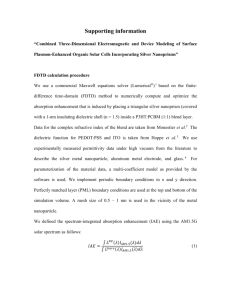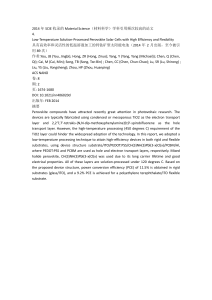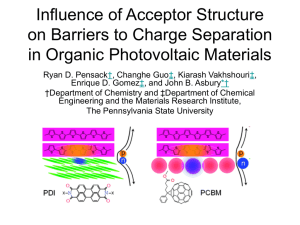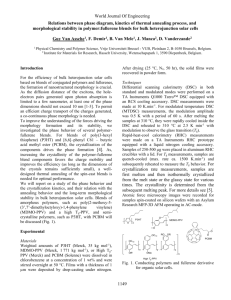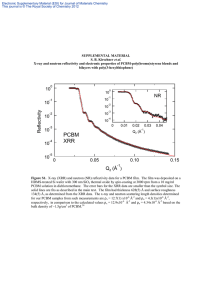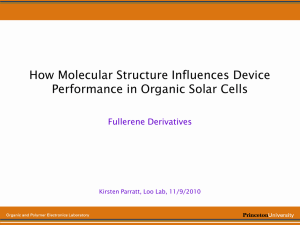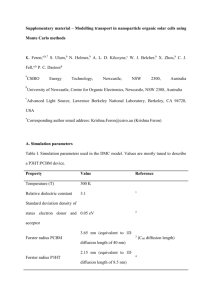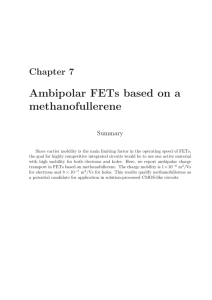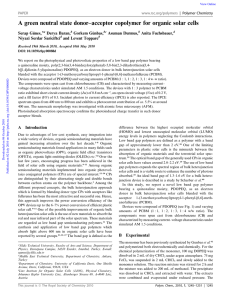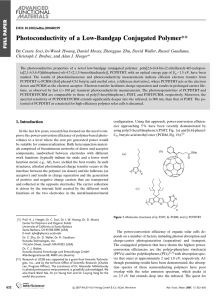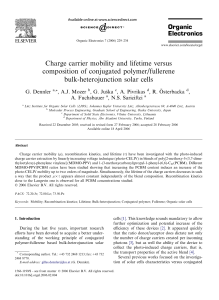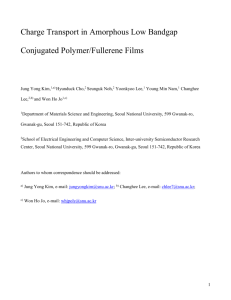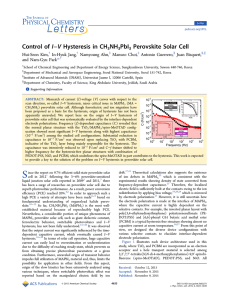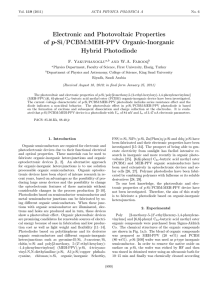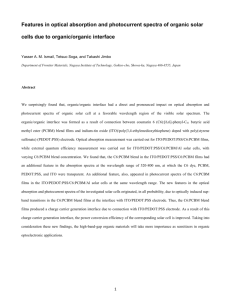J. Appl. Phys .SM(R1)
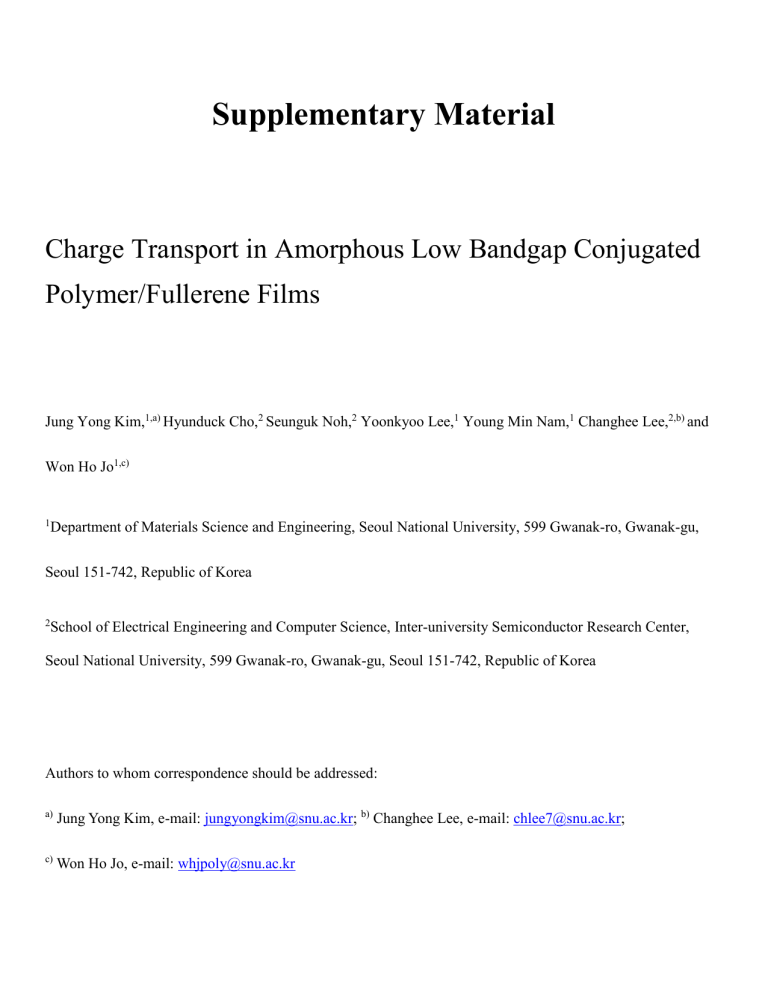
Supplementary Material
Charge Transport in Amorphous Low Bandgap Conjugated
Polymer/Fullerene Films
Jung Yong Kim,
1,a)
Hyunduck Cho,
2
Seunguk Noh,
2
Yoonkyoo Lee,
1
Young Min Nam,
1
Changhee Lee,
2,b) and
Won Ho Jo
1,c)
1
Department of Materials Science and Engineering, Seoul National University, 599 Gwanak-ro, Gwanak-gu,
Seoul 151-742, Republic of Korea
2 School of Electrical Engineering and Computer Science, Inter-university Semiconductor Research Center,
Seoul National University, 599 Gwanak-ro, Gwanak-gu, Seoul 151-742, Republic of Korea
Authors to whom correspondence should be addressed: a)
Jung Yong Kim, e-mail: jungyongkim@snu.ac.kr
; b)
Changhee Lee, e-mail: chlee7@snu.ac.kr
; c)
Won Ho Jo, e-mail: whjpoly@snu.ac.kr
Figure S1. Calculated reorganization energy (
i
≈ 0.31 eV) of the repeating unit of P(3HT-MeTDQ). Here it is assumed that the repeating unit contains +1 charge:
i
E o
E
E
0
E
0
1.122184 10
2
Hartree
0.303642213 eV where 1 Hartree = 27.2116 eV.
E
0
2854.38032636
: Energy of a cation with the optimized neutral-molecule structure.
E
2854.38616311
: Energy of a cation with the optimized cation structure.
E
0
2854.58611855
: Energy of a neutral molecule with the optimized cation structure.
E
0
2854.59150366
: Energy of a neutral molecule with the optimized neutral-molecule structure.
S2
Figure S2 . XRD pattern for the drop cast P(3HT-MeTDQ) film. Sample was annealed at 100 ˚C for 30 min. The trace of peak at 2
θ
= 25.5˚ was intensified when the polymer was blended with PCBM (see Figure 6 in the text).
S3
Figure S3. Determination of glass transition temperature ( T g
) from the DSC thermogram at scan rate of 10
K/min.
S4
nm
1
0
-1
(a) deg
0.8
0.4
0.0
-0.4
-0.8
(b)
500 nm
(c)
(b)
Figure S4.
The AFM tapping mode height (a) and simultaneously acquired phase lag (b) images of unannealed
P(3HT-MeTDQ) film. (c) The TEM image of the P(3HT-MeTDQ) film, which was annealed at 100 ˚C for 30 min.
S5
Figure S5 . Photocurrent transient of P(3HT-MeTDQ) in a log-log scale as a function of electric field ( T = 300
K). The arrow indicates the transit time.
S6
Figure S6 . Photocurrent transient of P(3HT-MeTDQ) in a log-log scale ( T = 300 K), when the road resistance
(R
L
) changes from 200 to 500 Ω. The arrow indicates the transit time. (a) Hole transient, in which the transit time does not change with varying the load resistance (R
L
), indicating the signals are correct. (b) Electron transient, in which the transit time changes with varying R
L
, indicating the signals are incorrect, i.e
., artifacts.
S7
(a)
(b)
Figure S7 . (a) Transfer and (b) output characteristic of the unannealed P(3HT-MeTDQ):PCBM (= 40:60 wt.%) transistor.
S8
(a) (b)
(c)
(d)
Figure S8 .
The dependence of device resistance upon channel length for 0
50 % PCBM compositions (a); the variation of contact resistance with PCBM concentration (b); a plot of contact resistance vs. gate voltage with different PCBM concentrations (c); device resistance vs. channel length for 60
100 % PCBM compositions(d).
The contact resistance [ R c
= R
S
(source resistance) + R
D
(drain resistance)] between organic semiconductor film and Au electrode is very important for device operation, because carrier injection and collection steps are limited by this R c value. It has been known that gold works better than other low work function metals as a contact electrode for PCBM (n-type semiconductors).
S1-S3
The total device resistance is defined as R
TOT
[Ω·cm]
= R’
TOT
[Ω] × W [cm] = R channel
+ R c
, where R channel
is the channel resistance associated with the cannel length in a semiconductor in OFET device.
S4,S5
Thus, if the channel length decreases, the R c contribution to R
TOT becomes
S9
larger. The extreme case is an OPV geometry, in which carriers migrate over 100-200 nm ( cf . 40-300 µm in
OFET).
Figure S8a shows a transmission line plot ( R
TOT
vs. L ) at V
G
=
80 V with compositional variation (0
50 wt % PCBM). It should be noted here that the data for 60
90 wt % were not linear. The linear extrapolation of the plot to L = 0 yields the value of R c
, as shown in Figure S8. The R c value of P(3HT-MeTDQ) is estimated 7.8
MΩ·cm, which is about one order higher than R c
( = 0.25 MΩ·cm) of P3HT as measured by a four probe method for the same architecture OFET with top contact gold electrode.
S4 When R c
is plotted against the PCBM content, it is observed that it increases first with increasing the PCBM content and then decreases, showing a maximum at 40 wt % PCBM. This is probably because the contact area between P(3HT-MeTDQ) and electrode decreases as the PCBM content increases up to 40 wt %. However, the resistance becomes lower at 50 wt %, because of the discrete morphology change at 50 wt %, as evidenced by TEM (Figure 6 in the text). When the contact resistance is plotted as a function of gate voltage, as shown in Figure S8c, the R c
decreases with increasing V
G
. The free carrier density ( N free
) was then calculated from the SiO
2
dielectric layer with thickness of 300 nm and gate voltage, using the capacitance (11.8 nF/cm
2
) of dielectric layer as measured by impedance spectroscopy. Figure S8d shows the device resistance for electrons as a function of channel length at various compositions (60-100 wt % PCBM). Linear relation was not observed for these OFETs. However, the average values of R c
for electron (several ten to several hundred MΩ·cm) were comparable to those for holes.
References for Supplementary Material
S1. P.M. Beaujuge, C.M. Amb, and J.R. Reynolds, Acc. Chem. Res., 43 , 1396 (2010).
S2. E.J. Meijer, D.M. de Leeuw, S. Setayesh, E. van Veenendaal, B.-H. Huisman, P.W.M. Blom, J.C. Hummelen,
U. Scherf, and T.M. Klapwijk, Nature Materials, 2 , 678 (2003).
S3. J. Zaumseil, and H. Sirringhaus, Chem. Rev., 107 , 1296 (2007).
S4. M.J. Panzer, and C.D. Frisbie, (Eds: Z. Bao, J. Locklin) Organic Field Effect Transistors, CRC Press (2007).
S5. I. Kymissis, Organic Field Effect Transistors: Theory, Fabrication and Characterization, Springer (2009).
S10
